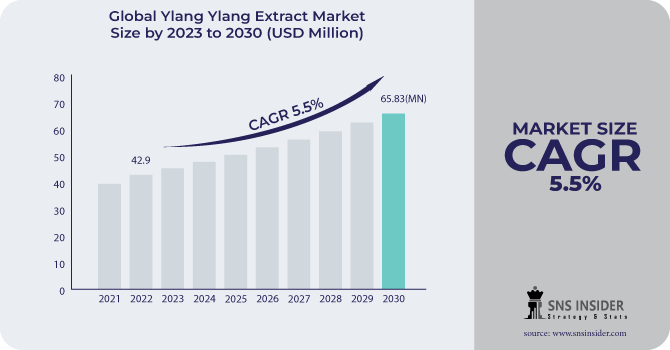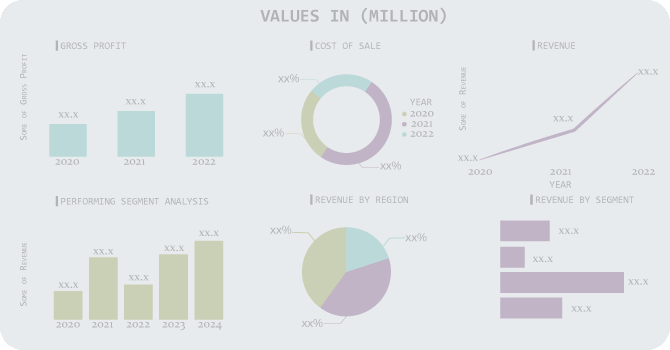Ylang Ylang Extract Market Report Scope & Overview:
The Ylang Ylang Extract Market size was USD 42.9 million in 2022 and is expected to Reach USD 65.83 million by 2030 and grow at a CAGR of 5.5% over the forecast period of 2023-2030.
Ylang Ylang Extract is a natural essential oil derived from the ylang ylang tree's blooms. The tropical tree ylang ylang is endemic to Southeast Asia and the Pacific Islands. The ylang ylang tree's blossoms are famous for their sweet and exotic aroma. The organic ylang ylang extract is produced using organic farming methods, which do not use synthetic pesticides or fertilizers. This makes the organic ylang ylang extract safer and healthier for consumers. The organic ylang ylang extract is also more sustainable, as it does not harm the environment.

Based on the distribution Channel, the Online retailer’s segment often offers the best prices, but they may also have higher shipping costs. Ylang ylang extract is widely available for purchase online through a variety of retailers, including Amazon, eBay, and Etsy.
Based on End users, the cosmetics and personal care segment will account for more than 44% of the market share in 2022. This segment's significant demand for ylang-ylang extract is related to its use in perfumes, body lotions, soaps, and shampoos.
MARKET DYNAMICS
KEY DRIVERS
-
Rising demand for natural and organic products
Consumers are increasingly seeking items manufactured from natural components and free of synthetic chemicals and artificial smells. Because of its lovely scent and therapeutic characteristics, ylang ylang essential oil is a popular choice for consumers seeking natural and organic products. Aromatherapy is also growing more popular, and ylang ylang essential oil is a popular choice for aromatherapy owing to its calming and relaxing qualities. The rising popularity of natural and organic products is likely to fuel the ylang ylang market's expansion.
RESTRAIN
-
Specific climatic conditions
Ylang ylang trees require a significant amount of water to thrive. Droughts can reduce yields and even kill trees, which can have a significant impact on the supply of ylang ylang essential oil. Floods can damage ylang ylang trees and wash away flowers, which can also reduce yields. Extreme weather events such as floods, droughts, and heat waves are becoming more often and intense as a result of climate change. This is a major challenge for the ylang ylang market, as it can lead to disruptions in production and increased price volatility.
OPPORTUNITY
-
Expanding markets in developing countries
Consumers in developing countries are spending more money on luxury things as their disposable incomes rise. Ylang ylang essential oil is used in many of these products, and rising demand for these items is propelling the ylang ylang market in emerging countries. Urban customers are more likely to be exposed to ylang ylang essential oil through the media and to have the spare income to buy ylang ylang goods. In emerging countries, increased awareness is fuelling demand for ylang ylang essential oil.
-
Growing demand for sustainable products
CHALLENGES
-
High prices of Ylang ylang
Ylang ylang essential oil is a rather expensive commodity, which may limit its market. Ylang ylang trees yield a tiny number of blooms, and only a small portion of these blossoms are used to make essential oil. The cost of ylang ylang essential oil can vary depending on a variety of factors, including crop yields and weather conditions. Furthermore, ylang ylang essential oil production is a labor-intensive procedure, which contributes to the high prices.
IMPACT OF RUSSIAN-UKRAINE WAR
Russia and Ukraine both contribute to the exports of ylang ylang flowers and their products, and the war has interrupted the supply of these products. As ylang ylang is an agricultural commodity, this could result in higher prices. The global aromatherapy market is predicted to reach USD 4.2 billion by 2028, although it may be hampered by essential oil and other cosmetics disruptions. In many places of the world, the war has also produced economic uncertainty and instability. This could reduce demand for ylang ylang in food and beverage, cosmetics, aromatherapy, and other industries because customers are less likely to spend money on discretionary items during times of economic instability.
IMPACT OF ONGOING RECESSION
The recession has impacted ylang ylang extract market. Ylang ylang products are relatively new in the market but it has a rising popularity in the cosmetics sector. However, manufacturers have witnessed reduced demand as consumers may opt for many alternate products. According to NielsenIQ, the global cosmetics industry will decrease by 0.2% in 2022. The cosmetics business is declining due to a variety of causes, including increased living costs, supply chain interruptions, and the war in Ukraine. According to Euromonitor International, the worldwide perfume and fragrance market is predicted to fall by 1.1% in 2022. The decline in this market has indirectly affected the ylang ylang market.
MARKET SEGMENTATION
By Nature
-
Organic
-
Conventional
By Extraction Method
-
Solvent Extraction
-
SCFE
By Distribution Channel
-
Supermarkets/ Hypermarkets
-
Specialty Stores
-
Online Retail
-
other
By End Use
-
Food & Beverage Industry
-
Cosmetic & Personal Care
-
Aromatherapy
-
Retail / Household
-
other
.png)
REGIONAL ANALYSIS
Asia Pacific is the largest market for ylang ylang extract, accounting for more than 35% of the worldwide market in 2022. This is due to ylang ylang extract being in high demand in the region's cosmetics and personal care, food and beverage, and aromatherapy industries.
North America has a large market for ylang ylang extract followed by Asia pacific, accounting for more than 25% of the worldwide market in 2022. The growing popularity of natural and organic products, as well as increased knowledge of the health advantages of ylang ylang extract, are driving demand in North America.
Europe region is a significant market for ylang ylang extract, accounting for more than 20% of the worldwide market share in 2022. The expanding popularity of luxury cosmetics and personal care products, as well as the increasing usage of ylang ylang extract in aromatherapy, are driving demand for ylang ylang extract in Europe.
Latin America is the emerging market for ylang ylang extract, accounting for less than 10% of the world market in 2022. However, due to the rising demand for natural and organic products in the region, the market is likely to rise significantly in the future years.
REGIONAL COVERAGE
North America
-
US
-
Canada
-
Mexico
Europe
-
Eastern Europe
-
Poland
-
Romania
-
Hungary
-
Turkey
-
Rest of Eastern Europe
-
-
Western Europe
-
Germany
-
France
-
UK
-
Italy
-
Spain
-
Netherlands
-
Switzerland
-
Austria
-
Rest of Western Europe
-
Asia Pacific
-
China
-
India
-
Japan
-
South Korea
-
Vietnam
-
Singapore
-
Australia
-
Rest of Asia Pacific
Middle East & Africa
-
Middle East
-
UAE
-
Egypt
-
Saudi Arabia
-
Qatar
-
Rest of Middle East
-
-
Africa
-
Nigeria
-
South Africa
-
Rest of Africa
-
Latin America
-
Brazil
-
Argentina
-
Colombia
-
Rest of Latin America
KEY PLAYERS
Some major key players in the Ylang Ylang Extract Market are AG Industries, Firmenich SA, VedaOils, HERBO NUTRA, Banyan Botanicals, Robertet, Norex Flavours Private Limited, BOS Natural Flavors (P) Limited., HDDES Group, Falcon Essential Oils., and other key players.
AG Industries-Company Financial Analysis

RECENT DEVELOPMENTS
In May 2023, Niyama Wellness by AHG expanded its portfolio with the addition of the Ylang Ylang Spa at Club Punta Fuego. The spa is located in San Juan, Batangas, Philippines, and offers massages, facials, body wraps, and yoga courses, among other health treatments and programs. The Ylang Ylang Spa is named after the Philippines' native ylang ylang flower.
In October 2022, Tarlac Ylang-Ylang presently generates essential oil for Sarangani's ethnic communities. The seeds from Tarlac's Ylang-ylang trees are already producing the perfume-quality scent of this flowering tree's essential oil, and more of this tree will be planted in other places to create enough volume for export.
In January 2022, Pangasinan groups to produce ‘ylang-ylang’ essential oil. People's organizations in the Pangasinan towns of Aguilar, Mangatarem, and Bugallon have collaborated with the Skin Station and Chemworld Fragrance Factory in the Philippines to create ylang-ylang essential oils.
| Report Attributes | Details |
| Market Size in 2022 | US$ 42.9 Million |
| Market Size by 2030 | US$ 65.83 Million |
| CAGR | CAGR of 5.5 % From 2023 to 2030 |
| Base Year | 2022 |
| Forecast Period | 2023-2030 |
| Historical Data | 2019-2021 |
| Report Scope & Coverage | Market Size, Segments Analysis, Competitive Landscape, Regional Analysis, DROC & SWOT Analysis, Forecast Outlook |
| Key Segments | • By Nature (Organic, Conventional) • By Extraction Method (Solvent Extraction, SCFE) • By Distribution Channel (Supermarkets/ Hypermarkets, Specialty Stores, Online Retail, and other) • By End User (Food & Beverage Industry, Cosmetic & Personal Care, Aromatherapy, Retail / Household, and other) |
| Regional Analysis/Coverage | North America (US, Canada, Mexico), Europe (Eastern Europe [Poland, Romania, Hungary, Turkey, Rest of Eastern Europe] Western Europe] Germany, France, UK, Italy, Spain, Netherlands, Switzerland, Austria, Rest of Western Europe]), Asia Pacific (China, India, Japan, South Korea, Vietnam, Singapore, Australia, Rest of Asia Pacific), Middle East & Africa (Middle East [UAE, Egypt, Saudi Arabia, Qatar, Rest of Middle East], Africa [Nigeria, South Africa, Rest of Africa], Latin America (Brazil, Argentina, Colombia Rest of Latin America) |
| Company Profiles | AG Industries, Firmenich SA, VedaOils, HERBO NUTRA, Banyan Botanicals, Robertet, Norex Flavours Private Limited, BOS Natural Flavors (P) Limited., HDDES Group, Falcon Essential Oils |
| Key Drivers | • Rising demand for natural and organic products |
| Market Challenges | • High prices of Ylang ylang |

